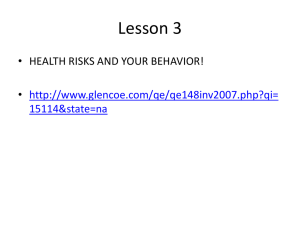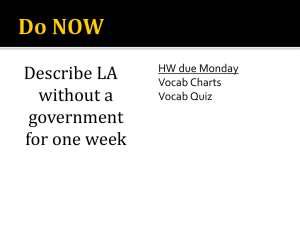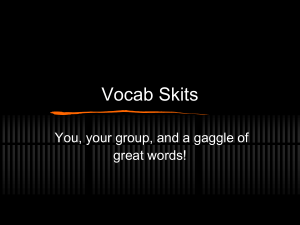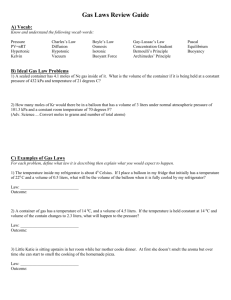Current Staff Casey Adam Course Earth Science Unit/ Length Unit
advertisement
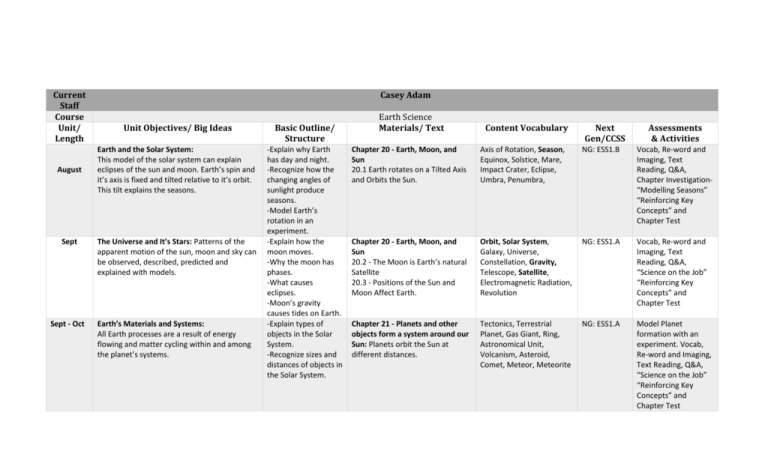
Current Staff Course Unit/ Length August Sept Sept - Oct Casey Adam Unit Objectives/ Big Ideas Basic Outline/ Structure Earth and the Solar System: This model of the solar system can explain eclipses of the sun and moon. Earth’s spin and it’s axis is fixed and tilted relative to it’s orbit. This tilt explains the seasons. -Explain why Earth has day and night. -Recognize how the changing angles of sunlight produce seasons. -Model Earth’s rotation in an experiment. -Explain how the moon moves. -Why the moon has phases. -What causes eclipses. -Moon’s gravity causes tides on Earth. -Explain types of objects in the Solar System. -Recognize sizes and distances of objects in the Solar System. The Universe and It’s Stars: Patterns of the apparent motion of the sun, moon and sky can be observed, described, predicted and explained with models. Earth’s Materials and Systems: All Earth processes are a result of energy flowing and matter cycling within and among the planet’s systems. Earth Science Materials/ Text Content Vocabulary Next Gen/CCSS Assessments & Activities Chapter 20 - Earth, Moon, and Sun 20.1 Earth rotates on a Tilted Axis and Orbits the Sun. Axis of Rotation, Season, Equinox, Solstice, Mare, Impact Crater, Eclipse, Umbra, Penumbra, NG: ESS1.B Vocab, Re-word and Imaging, Text Reading, Q&A, Chapter Investigation“Modelling Seasons” “Reinforcing Key Concepts” and Chapter Test Chapter 20 - Earth, Moon, and Sun 20.2 - The Moon is Earth’s natural Satellite 20.3 - Positions of the Sun and Moon Affect Earth. Orbit, Solar System, Galaxy, Universe, Constellation, Gravity, Telescope, Satellite, Electromagnetic Radiation, Revolution NG: ESS1.A Vocab, Re-word and Imaging, Text Reading, Q&A, “Science on the Job” “Reinforcing Key Concepts” and Chapter Test Chapter 21 - Planets and other objects form a system around our Sun: Planets orbit the Sun at different distances. Tectonics, Terrestrial Planet, Gas Giant, Ring, Astronomical Unit, Volcanism, Asteroid, Comet, Meteor, Meteorite NG: ESS1.A Model Planet formation with an experiment. Vocab, Re-word and Imaging, Text Reading, Q&A, “Science on the Job” “Reinforcing Key Concepts” and Chapter Test October Earth’s Materials and Systems: All Earth processes are a result of energy flowing and matter cycling within and among the planet’s systems. This energy is derived from the sun and earth’s hot interior. The energy that flows and matter that cycles produce chemical and physical changes in Earth’s materials and living organisms. -Explain how the sun produces energy. -Understand how energy flows through the Sun’s layers. -Describe solar features and solar winds. -INVESTIGATION: How does reflection affect temperature? -Explain how different kinds of fossils show traces of life from Earth’s past. Chapter 22 - Stars, Galaxies, and the Universe 22.1 - The Sun is our Local Star. NG: ESS2.A Chapter 15 - Earth’s Changing Atmosphere 15.2 - The Sun Supplies the Atmosphere’s Energy Fusion, Convection, Conduction, Radiation, Corona, Sunspot, Solar Wind, Light-year, Parallax, Nebula, Main Sequence, Neutron Star, Black Hole, Quasar, Doppler effect, Big Bang Vocab, Re-word and Imaging, Text Reading, Q&A, “Connecting Sciences: Carbon Cycle Chemistry” “Reinforcing Key Concepts” and Chapter Test Chapter 9 - Views of Earth’s Past. 9.1 - Earth’s Past is Revealed in Rocks and Fossils 9.3 - The Geologic Time Scale Shows Earth’s Past. Fossil, Original Remains, Ice Core, Relative Age, Absolute Age, Half-life, Uniformitarianism, Geologic Time Scale NG: ESS1.C Vocab, Re-word and Imaging, Text Reading, Q&A, “Reinforcing Key Concepts” and Chapter Test Vocab, Re-word and Imaging, Text Reading, Q&A, “Science on the Job” “Reinforcing Key Concepts” and Chapter Test Oct - Nov The History of Planet Earth: The geologic time scale interpreted from rock strata provides a way to organize Earth’s history. Relative Dating not absolute. Nov Biological Evolution: Evidence on Common Ancestry and Diversity: The Collection of Fossils and their placement in chronological order, through their location in sedimentary layers in which they are found through radioactive dating, known as the fossil record. It documents the existence, extinction, diversity,and change of many life forms throughout the history of life on Earth. -Learn about what the relative ages of rock layers reveal about Earth. -Explain how the geologic time scale describes Earth’s history. - Discuss prehistorical existence, extinction, diversity and change of organisms. Chapter 9 - Views of Earth’s Past. 9.1 - Earth’s Past is Revealed in Rocks and Fossils 9.3 - The Geologic Time Scale Shows Earth’s Past. LIFE SCIENCE TEXT: 6.1 (Copy) Fossil, Original Remains, Ice Core, Relative Age, Absolute Age, Half-life, Geologic Time Scale, Species, Organism, Unicellular Organism, Multicellular Organism NG: LS4.A Nov - Dec Plate Tectonics and Large Scale System Interactions: Maps of ancient land and water patterns, -Describe different properties of Earth’s four layers. Chapter 6 - Plate Tectonics 6.2 - Continents Change Position Over Time Density, Mineral, Rock, Inner Core, Outer Core, Mantle, Crust, Lithosphere, NG: ESS2.B Vocab, Re-word and Imaging, Text Reading, Q&A, based on investigations of rocks and fossils, make clear how Earth’s plates have moved great distances, collided, and spread apart. December January Feb The Roles of Water in Earth’s Surface Processes: Water movements-both on the land and underground-cause weathering and erosion, which change the land’s surface features and create underground formations. Water continually cycles among land, ocean, and atmosphere via transpiration, evaporation, condensation and crystallization and precipitation as well as downhill flows on land. The Roles of Water in Earth’s Surface Processes: The complex patterns of the changes and the movement of water in the atmosphere, determined by the winds, landforms, and ocean salinity, temperatures, and currents, are major determinants of local weather patterns. Weather and Climate: Weather and climate are influenced by interactions involving sunlight, the ocean, the atmosphere, ice, landforms, and living things, they vary with latitude, altitude, and local and regional geography, all of which can affect oceanic and atmospheric flow patterns. -Explain theory and evidence of plate tectonics. -Identify plate boundaries and movement. -Explain how water moves throughout Earth and it’s atmosphere. - Understand how much of Earth’s water is salt and fresh water, and how water collects and flows underground. 6.4 - Plates Converge or Scrape Past Each Other Asthenosphere, Tectonic Plate “Science on the Job” “Reinforcing Key Concepts” and Chapter Test Chapter 5 - Erosion and Deposition 5.2 - Moving Water Shapes Land 5.3 - Waves and Wind Shapes Land Chapter 11 - The Water Planet 11.1 - Water Continually Cycles 11.2 - Fresh Water Flows and Freezes on Earth. 11.3 - Fresh Water Flows Under Ground Drainage Basin, Divide, Floodplain, Alluvial Fan, Delta, Sinkhole, Longshore Drift, Longshore Current, Sandbar, Barrier Island, Dune, Loess, Atmosphere, Glacier, Evaporation, Condensation, Precipitation NG: ESS2.B Vocab, Re-word and Imaging, Text Reading, Q&A, “Science on the Job” “Reinforcing Key Concepts” and Chapter Test -Describe what causes ocean currents, how they interact with the climate and weather, and how they distribute heat around the globe. Chapter 13 - Ocean Systems 13.1 Oceans are a Connected Syst 13.2 - Ocean Water Moves in Currents Chapter 11 - The Water Planet 11.1 - Water Continually Cycles 11.2 - Fresh Water Flows and Freezes on Earth. Chapter 16 - Weather Patterns 16.2 The Atmosphere has Wind Patterns Chapter 18 - Climate and Climate Change 18.2 - Earth has a Variety of Climates Salinity, Density, Continental Shelf, Sonar, Ocean Current, Upwelling, Downwelling, El Nino, Rip Current, Tide, Tidal Range, Spring Tide, Neap Tide, Climate NG: ESS2.C Vocab, Re-word and Imaging, Text Reading, Q&A, “Science on the Job” “Reinforcing Key Concepts” and Chapter Test Weather, Wind, Global Wind, Coriolis Effect, Jet Stream, Monsoon, Latitude, Marine Climate, Climate Zone, Microclimate, Urban Heat Island, Rain Shadow NG: ESS2.D Vocab, Re-word and Imaging, Text Reading, Q&A, “Science on the Job” “Reinforcing Key Concepts” and Chapter Test March Weather and Climate: The ocean exerts a major influence on weather and climate by absorbing energy from the sun, releasing it over time and globally redistributing it through ocean currents. April Natural Hazards: Mapping the history of natural hazards in a region, combined with an understanding of related geologic forces can help forecast the locations and likelihoods of future events. May Natural Resources: Human’s depend on Earth’s land, oceans, atmosphere, and biosphere for many different resources. Minerals, fresh water and biosphere resources are limited, and many are not renewable or replaceable over human lifetimes. These resources are distributed unevenly around the planet as a result of past geological processes. -Describe what causes ocean currents, and how they distribute heat around the globe. -Recognize what makes a natural resource renewable or nonrenewable. -Determine the benefits and costs of using fossil fuels. -Model oil spill to explain damage to the environment. Chapter 13 - Ocean Systems 13.1 - The Oceans are a Connected System 13.2 - Ocean Water Moves in Currents ***Not sure our resources match up well. Will use online resources: NSGS, NOAA, News, Youtube, Nat Geo, etc. Chapter 7 - Earthquakes & Chapter 8 - Mountains and Volcanoes ***Not sure our resources match up well. Will use online resources: NSGS News, Youtube, Nat Geo, etc. Chapter 10 - Natural Resources 10.1 - Natural Resources Support Human Activity 10.2 - Resources can Be Conserved and Recycled Salinity, Density, Continental Shelf, Sonar, Ocean Current, Upwelling, Downwelling, El Nino, Climate Zone, Microclimate, Urban Heat Island, Rain Shadow, Acid Rain Fault, Stress, Earthquake, Seismic Wave, Focus, Epicenter, Seismograph, Aftershock, Tsunami, Folded Mountain, Faultblock Mountain, Volcano, Lava, Geyser Natural Resource, Renewable Resource, Nonrenewable Resource, Fossil Fuel, Conservation, Recycling NG: ESS2.D NG: ESS3.B NG: ESS3.A Vocab, Re-word and Imaging, Text Reading, Q&A, “Science on the Job” “Reinforcing Key Concepts” and Chapter Test Vocab, Re-word and Imaging, Text Reading, Q&A, “Science on the Job” “Reinforcing Key Concepts” and Chapter Test Vocab, Re-word and Imaging, Root-word guessing game. Text Reading, Q&A, “Science on the Job” “Reinforcing Key Concepts” and Chapter Test

